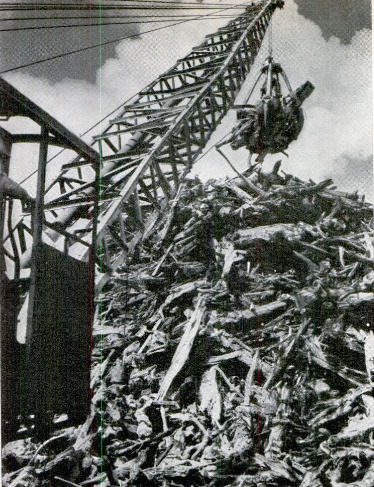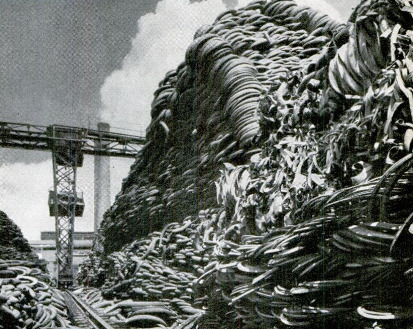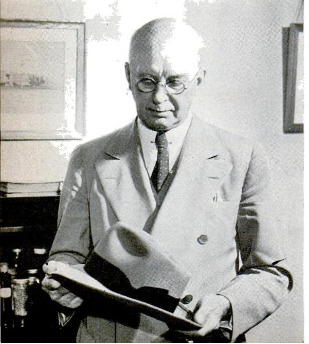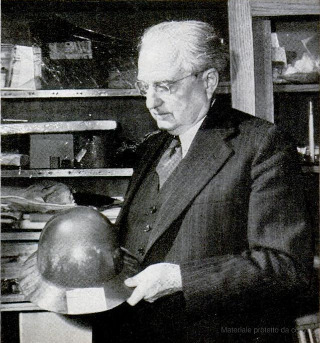-
Title (Dublin Core)
-
Chemurgy a strong new weapon
-
Article Title and/or Image Caption (Dublin Core)
-
Title: Chemurgy a strong new weapon
-
extracted text (Extract Text)
-
WHEN war threatens, a
wise nation takes stock
of its natural resources.
It catalogs those raw materials
of which it has an abundance,
those it must import, those it
must conserve, those it must do
without. This last category
brings up the question of sub-
stitutes.
Here, the United States is bet-
ter off than it was in 1917. If
our part in the last war had
lasted longer, if our defense pro-
gram had been larger, some of
our lacks and scarcities would
have become acute. Today,
though we are faced with great-
ly reduced imports and possible
shortages in metals, rubber, and
other materials, and though our defense
plans are far greater, we have a new pro-
tection against a crisis.
Our protection is our better understand-
ing of chemistry, due to multiplication of
research since, as a fruit of Allied victory in
the last war, leadership in the largest chem-
ical industries passed from Germany to the
United States. In 1920, the total amount
spent for chemical research in the nation
was $25,000,000; today a single company
spends $7,000,000 annually.
Early in the '30s a new phase developed in
this research. Dr. William Jay Hale called
it “chemurgy.” Its plan was to take a new
member, agriculture, into the partnership
between science and industry. If certain
products of the soil could be substituted for
minerals in industry, and if certain others
which had hitherto been used only for food
could be worked into a variety of manu-
factures, then exhaustible mineral and oil
deposits could be conserved and at the same
time the farmer could be restored to his old
economic independence. This sort of chem-
ical “magic” was laughed at by some indus-
trialists when it began, but much of it is
commonplace today.
The most familiar examples of chemurgy
are the use of casein derived from milk for
plastics and artificial wool; the celebrated
soybean oil and plastics; furfural for lubri-
cants from oat hulls; ethyl alcohol from
corn, barley, sweet potatoes, and Jerusalem
artichokes to blend with gasoline for fuel.
Since the first chemurgic conference at
Dearborn in 1935, chemurgy has made long
strides. Backed by the Chemical Founda-
tion and its late president, Francis P. Gar-
van; by Henry Ford; by Louis J. Taber,
Master of the Grange; and by the research
departments of many large companies in-
cluding Du Pont, it has found many research
facilities. Today, the powerful National
Farm Chemurgic Council, with branches in
28 states, includes among its governors pro-
fessors, chemical and agricultural engineers,
merchants, railroad presidents, editors, and
public-relations men. Its scope has expanded
to include forestry, water control, plant
breeding, crop diversification, unemploy-
ment, and many other things besides the
discovery of new uses for farm products. It
maintains close relations with large and
small farmers everywhere, giving them ad-
vice ranging from soil conservation to the
painting of their barns.
Though the threat of war was remote
from the minds of the conferees at Dearborn
in 1935, it is evident from the reports of 1941
that almost every chemurgic step in the
interval has been a help toward defense
economy.
It was thought, for example, that the
colossal defense demand for steel would stop
automobile production. But now it appears
that cellulose and protein plastics can be
used for car bodies to replace steel sheet.
Lately it has been announced that shortages
in wool need not interfere with upholstery in
new cars as a new artificial wool has been
evolved from soybean protein which can be
drawn into yarn after treatment with for-
maldehyde and sulphuric acid. Another re-
port tells of a plastic tractor seat. Every-
one has heard of the synthetic rubber from
coal and limestone, but this takes us back
to the mines. A new report from one of the
Government's recently built regional agri-
cultural laboratories tells of experiments
with synthetic rubber from corn.
A statement from the Office of Production
Management in Washington suggests pos-
sible aluminum shortage. But at the same
time comes the report of success in two air-
craft companies with molded wood plastics
for wings, fuselage, and tails of planes.
While it is not stated that these are fighter
craft, it would be a great stabilizing step if
war production in thia industry need not
limit normal production for commercial use.
In any case, late advices from England re:
port the extensive use of plastics as metal
substitutes in military aircraft. One new
British plane has 200 plustic parts.
‘The question of wood brings up a twofold
chemurgle problem, Anyone watching the
erection of the great new army cantonments
must be aware of the quantity of lumber
necessary. Even if the lumber is now avail-
able, 1s it not possible that the supply will
be 80 reduced as to send prices skyrocketing
for peacetime use later? Chemurgy has
devoted much time to wood substitutes.
Fiber boards made of such farm wastes as
wheat straw are already taking the place of
lumber as building materials. These straws
and stalks would otherwise be destroyed.
Now they can not only conserve our lum-
ber but prevent flooding and erosion by
Keeping forested areas intact. One speaker
at the Seventh Annual Chemurgie Confer-
ence in Larch of this year drew a picture of
the day when “the farmer's home and per-
haps 7ther buildings will be made of plas-
tick” produced from farm waste,
But chc second part of the wood question
involves the use of wood which is already
wasted in lumbering operations. This in-
cludes sawdust, chips, and twigs containing
cellulose and now widely used in plastics.
It also includes the unsightly stumps which
are left in the ground.
A story of the part stumps can play in
national defense was told at the 1941 Chem-
urgic Conference by Paul Mayfield, a chem-
ist for the Hercules Powder Company. In
Georgia, Florida, and Mississippi there are
billions of pine stumps in the cut-over lands
of the long-leaf pine belt.
“These uneconomic remnants of the lum-
bering industry,” said Mr. Mayfield, “. . .
are storehouses of latent wealth in the raw,
serving as the material for the production
of wood naval stores, one of chemurgy's
most important divisions.”
The term “naval stores,” he explained,
means more than it meant in the days when
the Phoenicians calked their ships and
treated rope with rosin. Today rosin is used
in linoleum, floor tile, soldering fluxes, elec-
trical insulation, soap, paint, thermoplas-
tics, matches, and many other things. Pine
oil, another stump product, is used in tex-
tile processing, in the flotation process of
mineral separation, and in the laundry. Still
another, Vinsol resin, is used in cement and
in asphalt emulsions for road surfacing.
Truline binder is still another product which
plays an important part in the making of
foundry cores. All these and others such as
special terpene hydrocarbons and alcohols,
rosin esters—all aids to a variety of defense
industries—can be got by the wholesome
conversion of stump-filled fields into pas-
turage and land for reforestation. Figura-
tively speaking, this is a way of getting
plowshares as a by-product of swords,
ANOTHER brand-new wood-waste prod-
uct was announced at the 1941 confer-
ence. This is a processed charcoal said to
be an effective substitute for coke. It can be
used for blast-furnace fuel for production
of high-grade iron, and also as a smokeless
domestic fuel because of its relative free-
dom from ash and its lack of sulphur and
phosphorus. Because there are an estimated
50,000,000 tons of wood waste—stumps, tree-
tops, sawdust—in the northwest lumber
country, this fuel might develop a steel in-
dustry on the Pacific coast.
‘Though we have gained immeasurably in
chemical industries since the last war, other
parts of our national balance sheets show
heavy losses. Chemurgy has been deeply
concerned in the disappearance of our cotton
markets and the resulting surplus which has
threatened so many southern planters with
ruin. The problem has been complicated by
the invention of the mechanical cotton-
picker.
The use of cotton in plastics, film, explo-
sives, rayon, and other things has helped. A
great opportunity has come with the dis-
covery that cotton fabric as a binder for
bituminous roads considerably reduces con-
struction costs and immeasurably decreases
maintenance charges. While tar or asphalt
cannot replace concrete for large main ar-
teries, thousands of miles of cotton-bound
secondary or “farm to market” roads can be
opened through the south at a cost of under
$4,000 a mile. Such a development would
help a defense as well as a peace economy.
And lately, a New York engineer, E. C.
Wallace, has made a suggestion for cotton
which is more directly concerned with de-
fense. He has shown that cotton is a better
material than concrete for the roofs of
bombproof shelters. A roof seven feet thick
made of cotton bales will resist the penetra-
tion of a 6,000-pound bomb falling from 30,
000 feet, whereas
a 2,000-pound bomb falling 15,000 feet will
penetrate six feet of reénforced concrete.
The cotton can be made resistant to fire.
Large chemurgic progress has been made
with corn, the outstanding American crop.
Zein, a protein by-product of cornstarch,
lends itself to the manufacture of yarn, but-
tons, laminated boards, wall-paper coating,
quick-drying printing ink, tin-foil substi-
tutes. As Zein for industrial use brings 15
to 20 cents a pound, it has been estimated
that from 40 to 60 cents may be added to the
value of a bushel of corn.
Chemurgists are vitally interested in
making the United States as self-suffi-
cient as possible. They are greatly concerned
over the reduction of imports. It has become
evident when certain imports such as glycerin
were forcibly cut off, that they could be
economically produced here. Starch, a heavy
import, may be made from white or sweet
potatoes with stock feed as a by-product.
The fractional distillation of American oils
can provide substitutes for imported oils,
according to chemurgic conference reports.
Chemurgists are agitating for the increased
American production of flax for both linseed
oil and linen (much in demand at present
by the Army and Navy) and this has been
made possible by the invention of a new
flax-gin, the “decoriator” which does away
with the old “retting” process.
‘While chemurgy will help national de-
fense, the vast defense effort will surely help
chemurgy. It has become a platitude that
many processes are made commercially
profitable when they are forced by a war
economy to function on a large scale. The
Haber-Bosch process for obtaining nitrogen
from the air is a conspicuous example of
this. So such things as the blending of al-
cohol with gasoline as a fuel—thought by
Dr. Hale and others to be the most far-
reaching chemurgic experiment—may be-
come an accomplished commercial fact in
America. This will reduce the drain on the
oil wells and put millions of new acres into
cultivation to the profit of the farmer.
The United States is thought the ideal
chemurgic laboratory of the world because
of its vast acreage of cultivable land, its
agricultural tradition, and its present high
position in chemical industry. For whereas
most European nations must confine their
limited land to food production, in America
there has been a food surplus with conse-
quent disaster to the producers. Chemur-
gists see a future in which both crop reduc-
tion and farm subsidies will disappear.
-
Contributor (Dublin Core)
-
Roger Burlingame (article writer)
-
Language (Dublin Core)
-
Eng
-
Date Issued (Dublin Core)
-
1941-08
-
pages (Bibliographic Ontology)
-
105-107,220
-
Rights (Dublin Core)
-
Public domain
-
Archived by (Dublin Core)
-
Sami Akbiyik
 Popular Science Monthly, v. 139, n. 2, 1941
Popular Science Monthly, v. 139, n. 2, 1941








